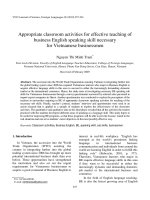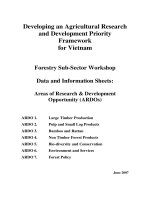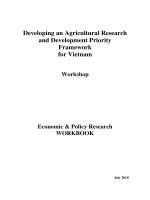Experiences of Green Credit Development Lessons Learned for Vietnam
Bạn đang xem bản rút gọn của tài liệu. Xem và tải ngay bản đầy đủ của tài liệu tại đây (93.87 KB, 8 trang )
VNU Journal of Science: Economics and Business, Vol. 32, No. 2 (2016) 69-76
INFORMATION
Experiences of Green Credit Development
Lessons Learned for Vietnam
Do Thi Van Trang*
VNU University of Economics and Business,
144 Xuan Thuy Str., Cau Giay Dist., Hanoi, Vietnam
Abstract
This article studies the experiences of green credit development in some countries in the world such as
China, Korea, and Germany. From the difficulties in applying green credit in China, or the successes of applying
green credit in Korea and Germany, this study highlights several recommendations and suggests lessons learned
from these countries for Vietnam.
Received 23 December 2015, revised 9 June 2016, accepted 28 June 2016
Keywords: Green economy, green banking, green credit.
1. Introduction *
strategy. One of the most effective issues that
has been applied in many countries is green
banking, which concentrates on green credit.
Sahoo and Nayak (2008) [1] and Bihari (2010)
[2] indicated the importance of green banking
in international experience and addressed
important lessons for sustainable banking and
development in India. Biswas (2011) [3] paid
attention to the major benefits, confronting
challenges and strategic aspects of green
banking. Commercial banks should become
green and implement a pro-active role to take
on environmental and ecological issues as part
of their lending principle. Commercial banks
should structure their economics for
environmental management purposes and the
use of green technologies and green
management systems. Bahl (2012) [4] and
Kaeufer (2010) [5] mentioned that green
banking should be concerned in promoting
environmental and social responsibility through
providing banking services in order to maintain
sustainable banking. Green banking is also
In recent years, the concept of a green
economy has become a controversial issue that
attracts attention not only from scholars but also
politicians. There have been several definitions
of the green economy; however, the United
Nations Environment Programme (UNEP) has
already emphasized a definition of a green
economy as being “one that results in improved
human well-being and social equity, while
significantly reducing environmental risks and
ecological scarcities”. The concept of a green
economy should be understood in accordance
with a broader concept of sustainable
development. This concept has highlighted
inter-generational equity-economics, both social
and environmental. In order to implement the
objectives of a green economy, many countries
have followed different macroeconomic
policies in their economic development
_______
*
Tel.: 84-915505445
E-mail:
69
70
D.T.V. Trang / VNU Journal of Science: Economics and Business, Vol. 32, No. 2 (2016) 69-76
taken into account with ethical banking that
starts with the aim of protecting the
environment. With the purpose of promoting a
green economy, many countries have carried
out various solutions to make amendments and
advocacy for environment protection and
sustainable development policies. Green credit,
among those numerous measures, is getting
vigorous attention and interest from both
government and international institutions. Many
commercial banks have started to put a higher
priority on investment projects to improve
environmental conditions and community
benefits. Green credit is a strategy to support
the economy to grow into a green, low-carbon
and recycling model through business
innovation, management over environmental
and social (E&S) risks, and improvement of
banks’ own E&S performances, and in doing
so, optimization of the credit structure,
improvement of services and contribution to the
transformation of the economic growth pattern.
The concept of green credit resembles that
of sustainable finance in that both concepts
highlight the potential of the financial sector to
respond to environmental and social
challenges of the world through financial
instruments. Green credit activities are those
that can bring about substantial benefits for
economic growth, people’s lives, and
environment protection as well as sustainable
development. Green credit policies are
significant measures in the transition into
green growth targets. Green credit products of
the banking systems are often used in projects
on energy saving, renewable energy and clean
technology. These priority sectors are
allocated in accordance with green credit
policies in different countries. However, most
of the current funds for green credit in
commercial banks are still based on
internationally financed projects/programs.
This is due to the lack of confidence and
assurance of banks regarding credit risks from
these investment projects. Aizawa and Yang
(2010) [6] described a series of green policies
applied by the government of China, including
green tax and green procurement, as well as
green policies relevant to the financial sector,
namely, green credit, insurance, and security
policies. As a consequence, green credit policy
is the most advanced with three agencies
sharing the responsibility for implementation.
Zhang, Yang and Bi (2011) [7] examined the
implementation of the green credit policy both
at the national and provincial levels in China
and proved that green credit policy is not fully
implemented in that country. Weiguang and
Lihong (2011) [8] showed there were
problems existing in China's green credit,
which were some external obstacles to its
efficient implementation. These difficulties
required an environmental risk management
system in the commercial banking system.
2. Experiences of green credit development in
some countries in the world
2.1. China
After many failures in controlling
environmental risks, the Chinese Government
aims to control pollution in firms via financial
institutions. A Circular of the People's Bank of
China on the Implementation of Credit Policies
and Strengthening Environmental Protection
issued on February 6, 1995 was the first official
document to link credit policies with
environment protection. On July 12, 2007, the
State Environment Protection Administration
(SEPA), the People's Bank of China, and the
China Banking Regulatory Commission (CBRC)
jointly issued the Opinions on Implementing
Environmental
Protection
Policies
and
Regulations to Prevent Credit Risks to emphasize
credit policies as tools for environmental
protection, and to strengthen environmental
monitoring and credit management of
construction projects and enterprises. This is the
basic framework of China's green credit policies.
CBRC is responsible for the supervision and
administration of the banks’ green credit
operations, and environmental risk management.
D.T.V. Trang / VNU Journal of Science: Economics and Business, Vol. 32, No. 2 (2016) 69-76
However, there was no detailed guidelines
for the Green Credit policy until 2012 when
CBRC issued Green Credit Guidelines. This is
why this policy was not considered effective
and efficient during this 5-year absence of
guidelines. The guidelines plan to establish an
environmental system, which covers tax, credit
and insurance policies to control and treat
environment pollution by the use of market
forces. Under the policies, enterprises that are
punished
by
environmental
protection
authorities will not be able to obtain further
credit from financial institutions and will also
have to repay their borrowed loans.
According to the Environmental Records of
Chinese Banks (Green Watershed, 2010) on
listed banks, very few banks have made strides
towards green credit. One of the reasons is their
lack of disclosure of environmental information.
Disclosure of environmental information is the
basis for the assessment of the banks'
performances in implementing environmental
policies and fulfilling their environmental and
social responsibilities. However, there is no
detailed guideline for disclosure of environment
information as this is only voluntary.
Consequently, banks still participate in
environmentally controversial projects, especially
overseas projects, and ignore criticism from
society. This research suggests the compulsory
regulation of financial institutions on the
disclosure of environmental information.
Another research in 2014 by an
international environmental non-governmental
organization,
E3G
(Third
Generation
Environmentalism), reported that financial
innovation can be led by financial institutions
championing green finance, like the China
Industrial Bank and the Shanghai Development
Bank, which are pioneers in using non-credit
instruments such as equity, guarantees and
insurance for green investments. The report also
suggested creating a platform for Low Carbon
Finance and Investment between the
Government,
financial
institutions
and
71
regulatory authorities on the green banking
pathway, with more integrated thinking and
policy dialogue. Public finance alone in China
has not always satisfied investment needs, so
the report recommended that China should try
new financing models such as public-privatepartnerships (PPP) together with a thorough
financial reform to support a larger impact. Due
to the emphasis on environment policies, China
surpassed many developed countries to become
the world’s largest green investment country
(IFC, 2011). Nevertheless, only one financial
institution is a member of Equator Principles
and 6 joined UNEP FI (updated until August
2014), a very small number for a large country
like China.
2.2. Korea
Korea has proved to be successful in
promoting green credit, but their experience is
quite different from other countries. Besides
banks that practice green operations, there is a
government non-profit credit guarantee
institution founded in 1989, called the Korea
Technology Finance Corporation (KOTEC).
This institution acts as a credit guarantee
system to solve the problem of lack of financial
resources due to the banks' prevalent collateralbased lending practice. It enables businesses
with competitive and environmental friendly
technology, innovation and other knowledgebased business content at all growth stages. The
mission of KOTEC is to take a lead in
converting the Korean economy to be creative
and innovative. KOTEC is also the only
financial institution to assess and grant “green”
licenses to businesses. Until 2013, 65 per cent
of green businesses have received support from
KOTEC. From 2011 to 2013, KOTEC granted
guarantees for green investment of up to 10,000
billion Won (equivalent to US$9.24 billion).
Each firm who received a green license can
apply for the guarantee of up to 7 billion Won
(US$6.49 million). Firms who received
excellent green licenses can obtain special
support from KOTEC, such as an increase in
the guarantee amount based on the number of
72
D.T.V. Trang / VNU Journal of Science: Economics and Business, Vol. 32, No. 2 (2016) 69-76
green-tech experts (30 million Won for each
expert), the age of the experts, and support for
research and development expenses and
copyright registration fees.
2.3. Germany
In the transition into a green economy,
green banking plays a crucial role in providing
funds for the green activities of the private
sector because the banking system is such a
blood vessel for the whole economy. Germany
has been successfully implementing its green
credit policies. The German state-owned KfW
Group - the national development bank supports Germany’s development policy,
international development cooperation and
sustainability strategy. Sustainability is one of
KfW’s primary business targets, being
responsible for promoting environmental and
climate protection worldwide. Moreover, KfW
is also committed to social responsibility and
participating in dialogue with its stakeholders.
Good corporate governance plays an important
role in the banking development.
Germany has universal banking. Private
customers mostly have to choose between three
kinds of banks (German “three pillar system”):
(A) Private banks (including direct banks)
The largest ones are Deutsche Bank,
Postbank (acquired by Deutsche Bank),
Unicredit Bank AG (HypoVereinsbank),
Commerzbank and Dresdner Bank (which was
acquired by Commerzbank in 2008) - they
cooperate together as the Cash Group.
(B) Cooperative banks
Co-operative banks make up about two
thirds of all German retail banks, and have a
broad customer base made up of individuals
and small businesses. However, their small size
means they only account for about 11 per cent
of total bank assets. Nevertheless, co-operative
banks are a very important part of the German
economy. They are significant lenders to small
and medium-size enterprises, many of them
also co-ops, which are the bedrock of the
German economy.
Co-operative banks (e.g. GLS bank) are
owned by their members, who broadly are their
customers - depositors and borrowers although most of the banks accept non-member
customers as well. Each member has one vote,
regardless of their contribution to the
cooperative bank. Co-operative principles apply
not only within individual banks but also across
the sector as a whole, with stronger banks
supporting weaker ones. This means cooperative banks can stay small and local, and
prevents them from taking excessive risks.
Because of this, the German co-op banking
sector required no public funds in the recent
financial crisis: few bank failures were handled
within the sector itself. Co-operative banks
continued to provide finance throughout the
crisis period - in fact increasing lending in
2008-9. The speedy recovery and subsequent
robust performance of the German economy is,
to a considerable extent, due to the stability and
resilience of the co-operative banking sector.
(C) Public savings banks
Savings banks in Germany work as
commercial banks in a decentralized structure.
Each savings bank is independent, locally
managed and concentrates its business activities
on customers in the region where it is located.
In general, savings banks are not profit
oriented. Shareholders of the savings banks are
usually single cities or numerous cities in an
administrative district.
They are intended to develop solutions for
people with low income to save small sums of
money and to support business start-ups.
Fulfilling public interests is still one of the most
significant characteristics of public banks in
general and the savings banks in particular.
Savings banks are universal banks and provide the
whole spectrum of banking services for private
and commercial medium-sized customers.
In Germany, there is not a green banking
strategy. Actually, the demand for green
banking has increased after the financial crisis
in the year 2009, because green banking,
especially green banks, were not severely
affected by the financial crisis. Almost every
D.T.V. Trang / VNU Journal of Science: Economics and Business, Vol. 32, No. 2 (2016) 69-76
bank in Germany offers green investment
products, but only four green banks have fully
integrated sustainability into their business
models, including GLS, UmweltBank, Triodos
and EthikBank. These are small and medium
sized banks, possibly commercial banks,
savings banks or cooperative banks. The
operating target of these banks is to mobilize
funds from their members and depositors who
have good awareness and willingness to achieve
low depositing interest rates with the aim of
investing in meaningful and environment
protection social activities. Meanwhile,
borrowers will have to obtain a high lending
interest rate because their environment protection
products will be sold at a very high price in the
market. Especially, customers are willing to buy
these expensive products as long as they can
assure those products come from green
investment companies. Investment sectors are
clean energy, renewable energy, energy savings,
environment protection, organic production, and
housing for the poor, education and support for
the disabled.
Among the above-mentioned banks, GLS
was voted as ‘the bank of the year’ in Germany
for five consecutive years (2010-2014) and got
the prize namely ‘the most sustainable
enterprise’ in 2012. In GLS, depositors will
have the right to choose specific sectors in
which they like their money to be invested. In
addition, to ensure transparency in financing
activities information, GLS also makes public
to the depositors all the lists of their loans
divided into specific sectors.
Likewise, the establishment of environment
protection units to implement green credit
policies plays a critical role in Germany. During
the process of implementing green credit
policies in Germany, these units will have to
ensure price reduction policies to support the
projects in environment protection and
energy savings.
3. Recommendations - Lessons learned from
other countries for Vietnam
The implementation of active solutions
from the banking system to promote and
73
mobilize credit funds to be invested in green
and environment friendly projects may create
many benefits, as follows:
- From the national aspect: The
development of green credit - green banking
will make progressive contributions to the
balance
and
harmonization
between
environment,
economic
and
social
development, poverty reduction, and the
improvement of people’s lives. In addition, it
would help Vietnam to prevent the social and
environmental risks faced by many countries
that did not take into consideration their
environment issues in their economic growth
strategy. Furthermore, this can create great
opportunities
for
international
finance
institutions to invest in Vietnam.
- From the business aspect: Green credit
offers a wide range of new environmental
products to their clients to earn more revenue
and ensures the enterprises go green. It means
that if enterprises emphasize the fact that they
are attempting to be environmentally friendly
they will gain the favor of like-minded
consumers, save cost because of saving energy,
and enhance their reputation as well as
competitive advantages in the fierce market.
However, the most important objective is to
increase consumer demand. As environmental
consciousness grows, consumers are demanding
more
green
products
and
services.
Environmentally conscious consumers check
labels to learn if products and packages are
made of recycled materials. Due to this growing
consciousness, the market share for green
products has continued to expand in a variety of
industries. Enterprises can tap into this market
by offering more green products and services.
- From the banking system aspect: Green
credit not only ensures that enterprises go
green, but also facilitates in improving the asset
quality of banks in the future via feasible and
efficient loans. Even in this global integration,
firms are required to reach higher standards to
export products, such as the requirement for a
green label, an ecological label, or a green
license. The regulation therefore become
74
D.T.V. Trang / VNU Journal of Science: Economics and Business, Vol. 32, No. 2 (2016) 69-76
stricter and stricter on the environment impact
of firms, and thus can result in legal risks for
the borrowers if they cannot meet them.
Therefore, it is wise for financial institutions to
assess the environmental impact of their
borrower’s project before lending, or advise
clients to do so. Therefore, green credit can help
protect the bank’s asset portfolio quality by
decreasing
non-performing
loans,
thus
increasing financial stability and maintaining
the bank’s reputation. Being aware of those
benefits, more and more banks have joined in
the Equator Principles, which provide
guidelines to facilitate banks on how to go
green, with the IFC initiative. Since 2006,
banks have been selected annually for best
practice in their environmental performance in
the Sustainable Banking Awards, held by IFC,
and results show that the best green banks, like
Dash (2008) [9] Triodos (2009) [10], Itau
Unibanco (2011), Standard Chartered (2012),
Banco Santander (2013), have proved to have
increasingly better financial performance over
time, even in years of financial crises.
- From the community and customers
aspect: Green credit supports to protect the
environment and human health while providing
other social and economic benefits to
communities. Moreover, the development of
green credit will provide customers with many
opportunities to use clean and environment
friendly products and restrict poisonous products.
Furthermore, green credit indirectly contributes to
improving the living environment and maintain
natural resource benefits for the next generations.
The role of green credit is also expressed in
raising the awareness of managers, enterprises
and individuals about the significance of green
investment for sustainable development.
The lessons learned from the Green
Credit Policy of China is very useful for
Vietnam. One of the greatest difficulties in
implementing green credit policy in China, that
Vietnam may consider, is the lack of a reliable
evaluation system for the polluting trades and
sectors as a basis for banks to classify the
project, especially as many polluting industries
are also expected to produce high profits for
many locals. If the Vietnam banking sector
goes down this path, this will also probably be
the biggest challenge, and may become a reason
for banks to delay and evade credit reductions
for polluting industries, which will affect
livelihoods, but bring more profits for
businesses and banks.
At the same time, the introduction of
regulations and detailed guidelines on green
credit policy is very important for enterprises
and banks to operate. This also requires close
coordination between relevant ministries to
expedite
the
complex
administrative
procedures. This will cause a significant impact
on the promulgation of policies in order to
improve the legal framework for promoting
green credit operations in Vietnam.
From the experience of South Korea,
Vietnam may consider to establish a
governmental credit guarantee institution. This
institution will support banks and financial
organizations who lack funds, to grant credit for
those enterprises which use friendly
environmental technologies. Furthermore, one
needs to draw lessons for Vietnam of the need
for the involvement of he senior political
system to solve problems related to transition
and institutional reforms, as well as the
proactive intervention of the Government for
the legal and institutional framework of green
credit growth. Government intervention can
maximize the power and influence of the
market on green credit growth, as well as an
incentive system to encourage the involvement
of the private sector. The harmonious and
efficient combination from the top down and
bottom up of the political system is the key for
the success of a green credit growth strategy.
Comprehensive solutions as mentioned above
will provide the vision and clarify the medium
to long-term target of green credit growth.
These solutions mean consultation and
cooperation to persuade stakeholders and
promote effectively coordination in the banking
system and businesses. The active engagement
of the community from the ground up creates a
sustainable platform for the growth of green
credit. Therefore, policies should include the
D.T.V. Trang / VNU Journal of Science: Economics and Business, Vol. 32, No. 2 (2016) 69-76
participation of the community and increase the
sense of community about green credit growth
as well as offering measures to change the
behavior of the community. Raising green
credit communication is very necessary in local
and rural areas across the country. The next step
is to mobilize global cooperation when the
backing of the senior political system, the
participation of the Government, and the
community have become available.
Lessons
learnt
from
Germany:
Enterprises that invest in green technology
mostly meet advantages, because products with
the green label are favored by consumers
despite high prices. Therefore, raising
awareness of consumers about using
environmentally friendly products, and
boycotting products that are not clean or
environmentally polluted is crucial. On the
other hand, the support of the government could
help enterprises reduce green production costs.
The second success lesson from Germany is
the transparency of information, when banks
expose their loan portfolio. Meanwhile, in
contrast is the opposite lesson of China, where
there was no requirement of disclosing
information, so banks hid their loans for
businesses that caused environmental pollution
and ignored public opinion. Therefore, it is
necessary for Vietnam to set up rules that banks
are required to report information on the
environmental performance of its loan to the
relevant authorities and the public.
In addition, Vietnam also considers
experience from developing countries such as
Bangladesh, under which central banks play an
important role in the promulgation of policies
and guidelines to support businesses in
developing green credit products. For example,
solar energy research: solar housing systems
and water-pumping stations for irrigation using
solar energy. Vietnam is an agricultural country
so this model is believed greatly effective.
4. Conclusion
This article has highlighted some
definitions of green economy, green banking
75
and green credit. Furthermore, this study has
taken into account the experiences of green
credit development in some countries all over
the world, for instance, China, South Korea,
Bangladesh, and Germany. Based on the
difficulties in applying green credit in China, or
the successes of green credit in other countries
like South Korea, Bangladesh and Germany,
this
study
has
emphasized
several
recommendations and suggests lessons learned
for Vietnam. Firstly, Vietnam has to consider a
reliable evaluation system for the polluting
trades and sectors as a basis for banks to
classify a project, especially as many polluting
industries are also expected to produce high
profits for many locals. Secondly, the
communication about the regulations and
detailed guidelines on green credit policy is
very important for enterprises and banks to
operate. Thirdly, establishing a governmental
credit guarantee institution to support banks and
financial organizations, which have a lack of
funds to grant credit for enterprises, which use
friendly environmental technologies. Finally,
setting up rules that banks are required to report
information on the environmental performance
of its loan to the relevant authorities and the
public should be considered in the Vietnamese
banking system.
References
[1] Sahoo, P., & Nayak, B. P., Green banking in
India, Institute of Economic Growth, 2008.
[2] Bihari, S. C., “Green banking-towards socially
responsible banking in India”, International
Journal
of
Business
Insights
&
Transformation, 4 (2010).
[3] Biswas, N., “Sustainable Green Banking
Approach: The Need of the Hour”, Business
Spectrum, 1 (2011) 1, 32-38.
[4] Bahl, S., “Green banking - The new strategic
imperative”, Asian Journal of Research in
Business Economics and Management, 2
(2012) 2, 176-185.
[5] Kaeufer, K., Banking as a Vehicle for Socioeconomic Development and Change: Case Studies
76
D.T.V. Trang / VNU Journal of Science: Economics and Business, Vol. 32, No. 2 (2016) 69-76
of Socially Responsible and Green Banks,
Cambridge, MA: Presencing Institute, 2010.
[6] Aizawa, M., & Yang, C., “Green credit, green
stimulus,
green
revolution?
China’s
mobilization of banks for environmental
cleanup”, The Journal of Environment &
Development, 19 (2010) 2, 119-144.
[7] Zhang, B., Yang, Y., & Bi, J., “Tracking the
implementation of green credit policy in
China: Top-down perspective and bottom-up
reform”,
Journal
of
environmental
management, 92 (2011) 4, 1321-1327.
[8] Weiguang, C., & Lihong, L., “The External
Obstacles of Green Credit Development and the
Construction of Environmental Risk Management
Framework in Chinese Commercial Banks [J]”,
Journal of Guangdong University of Finance, 3
(2011), 007.
[9] Dash, R. N., Sustainable ‘Green’ Banking:
The Story of Triodos Bank, Cab Calling,
2008, 26-29.
[10] />









